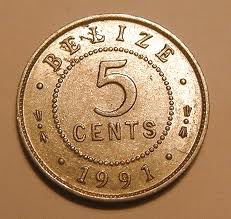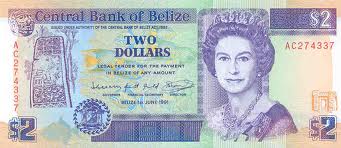|


The Belize dollar is the official currency in Belize, formerly known as British Honduras; (currency code BZD) is normally abbreviated with the dollar sign $, or alternatively BZ$ to distinguish it from other dollar-denominated currencies. It is divided into 100 cents. The official value is pegged at 2 BZ$ = 1 US$ since 1978.
History
The history of currency in Belize, formerly known as British Honduras, diverged from that of the rest of the British West Indies towards the end of the nineteenth century. In the year 1885, a new currency unit was introduced for British Honduras that was based on the US dollar, whereas the rest of the British West Indies continued to use British sterling coinage right up until 1955. And even though British Honduras joined the sterling area in 1939, the British Honduras dollar continued to maintain its parity with the American unit until the great sterling devaluation of 1949, when it switched its peg to sterling and devalued in sympathy. In 1973, British Honduras was renamed Belize and the modern Belize dollar (currency code BZD) is normally abbreviated with the dollar sign $, or alternatively BZ$ to distinguish it from other dollar-denominated currencies. It is divided into 100 cents. In 1978 the Belize dollar switched its peg away from sterling and back to the US dollar again at the fixed rate of BZ$2 = US$1. This rate, which continues up until the present day, reflects the devaluation of the British Honduras dollar which has taken place relative to the US dollar since 1949, when it was last on par. The British Honduras dollar is therefore worth only 50% of its original 1885 value in relation to the US unit.
The first dollars to circulate in British Honduras were Spanish dollars, some of which were counterstamped with the monogram of a crowned –G-R– (Latin: Georgius Rex, King George.) They circulated between 1765 and 1825 at a value of 6 shillings 8 pence.
In 1825, an imperial order-in-council was passed for the purpose of introducing the British sterling coinage into all the British colonies. This order-in-council made sterling coinage legal tender, and it set the exchange rate between sterling and the Spanish dollar at $1 = 4s 4d. This exchange rate was supposed to be based on the value of the silver in the Spanish dollars as compared to the value of the gold in the British sovereigns. The realistic exchange rate would have been $4.80 = £1 (equivalent to $1 = 4s 2d), and so the unrealistic exchange rate that was contained in the 1825 order-in-council led to the initiative being largely a failure. Remedial legislation came about in 1838 with a new order-in-council, which did not apply to the British North American colonies due to minor rebellions in Upper and Lower Canada. The 1838 legislation introduced the correct rating of $1 = 4s 2d.
However, when the original order-in-council of 1825 was introduced in Jamaica, Bermuda, and British Honduras, the local authorities set aside the mistaken rating of $1 = 4s 4d, and they unofficially used the alternative rating of $1 = 4s. The Bahamas would also later adopt this same approach. When the 1838 remedial legislation came into force, sterling was already well established in these territories, the Spanish dollar had been barred from circulation, and the authorities had no desire to adopt the devaluation that would have been associated with the correct rating of $1 = 4s 2d. The British shilling, referred to locally as a 'Maccaroni', was equal to one quarter of a dollar, and the system was working very satisfactorily.
So for a period in the middle of the nineteenth century, British Honduras operated the British sterling monetary system just like Jamaica and Bermuda. However, in the wake of the international silver crisis of 1873, the silver peso of neighbouring Guatemala drove the British currency out of circulation. In an attempt to return British Honduras to the gold standard, and also influenced by the fact that most imports were now coming from New Orleans in the USA, a new currency was introduced into British Honduras based on the US dollar, hence bringing British Honduras into line with Canada. At that time, the Canadian dollar was on the gold standard, and one Canadian dollar was equal to one American dollar. This is the point where the currency history of British Honduras diverges from that of the rest of the British West Indies. In 1885, 1 cent coins were issued, followed by higher denominations in 1894. This year also saw the first issue of banknotes by the Government and a switch from the silver Guatemalan peso to the gold U.S. dollar as the base for the currency, with $4.866 = 1 pound. The rate of $4.866 as opposed to $4.80 is explained by the fact that when the US dollar was first created in 1792, it was based on the average weight of a selection of worn Spanish dollars. Hence the US dollar was at a slight discount in relation to the Spanish dollar. Following the introduction of the US dollar gold standard to British Honduras, the 25 cent coins were referred to as shillings due to their closeness in value to shilling sterling.
When the United Kingdom abandoned the gold standard in 1931, the British Honduras dollar continued with its attachment to the US dollar unit, and as such it did not become part of the sterling bloc. However, at the outbreak of the second world war, unlike in the case of Canada, Newfoundland, and Hong Kong, British Honduras did join the sterling area even though it maintained its fixed exchange rate with respect to the US dollar. (The sterling bloc should not be confused with the sterling area. The former was a group of countries who pegged their local currencies to sterling when the United Kingdom abandoned the gold standard in 1931, whereas the latter was an exchange control arrangement introduced as an emergency measure at the outbreak of the second world war). In 1949 however, the British pound was devalued from US$4.03 to US$2.80. Since the British Honduras dollar was pegged to the US dollar, this caused a sudden increase in the value of the British Honduran dollar relative to the pound. Protests ensued which led to a devaluation of the British Honduran dollar to a value of 70 U.S. cents (equal to 5 shillings sterling). Following Harold Wilson's devaluation of sterling in November 1967, the British Honduran dollar again devalued in sympathy with the British pound to 60 US cents. In 1978, the link to the British pound of BZ$4 = £1 was abandoned and once again the Belize unit was pegged to the US dollar at a fixed rate of BZ$2 = US$1. This new rate which still continues today, reflects the devaluation of 50% in relation to the original parity with the US dollar in 1885, which last applied in 1949.
For a more general outline of currencies in the British Caribbean region, see Currencies of the British West Indies.
Coins
In 1885, bronze 1 cent coins were introduced, followed by silver 5, 10, 25 and 50 cents in 1894. These coins were minted at the Royal Mint and their style was similar to that of other British colonial dollar fractional coinage used in Hong Kong and Canada. Cupronickel replaced silver in the 5 cents in 1907. This was itself replaced by nickel-brass in 1942. In 1952, cupro-nickel replaced silver in the 25 cent coins, with the same happening for the 50 and 10 cents in 1954 and 1956, respectively. Following a reduction in size in 1954, the 1 cent coin switched to a scalloped shape in 1956. In 1976, aluminium 1 and 5 cents were introduced. A nickel-brass, decagonal 1 dollar coin was introduced in 1990
Banknotes
In 1894, the government introduced notes in denominations of 1, 2, 5, 10, 50 and 100 dollars. Production of 50 and 100 dollars ceased after 1928. 20 dollar notes were introduced in 1952. In 1980, the Monetary Authority of Belize took over note production and reintroduced the 100 dollar note. The Central Bank of Belize assumed responsibility for paper money production in 1983. Production of 50 dollar notes recommenced in 1990, the same year that the 1 dollar note was replaced by a coin.
The text on this page has been made available under the Creative Commons Attribution-ShareAlike License and Creative Commons Licenses
|
